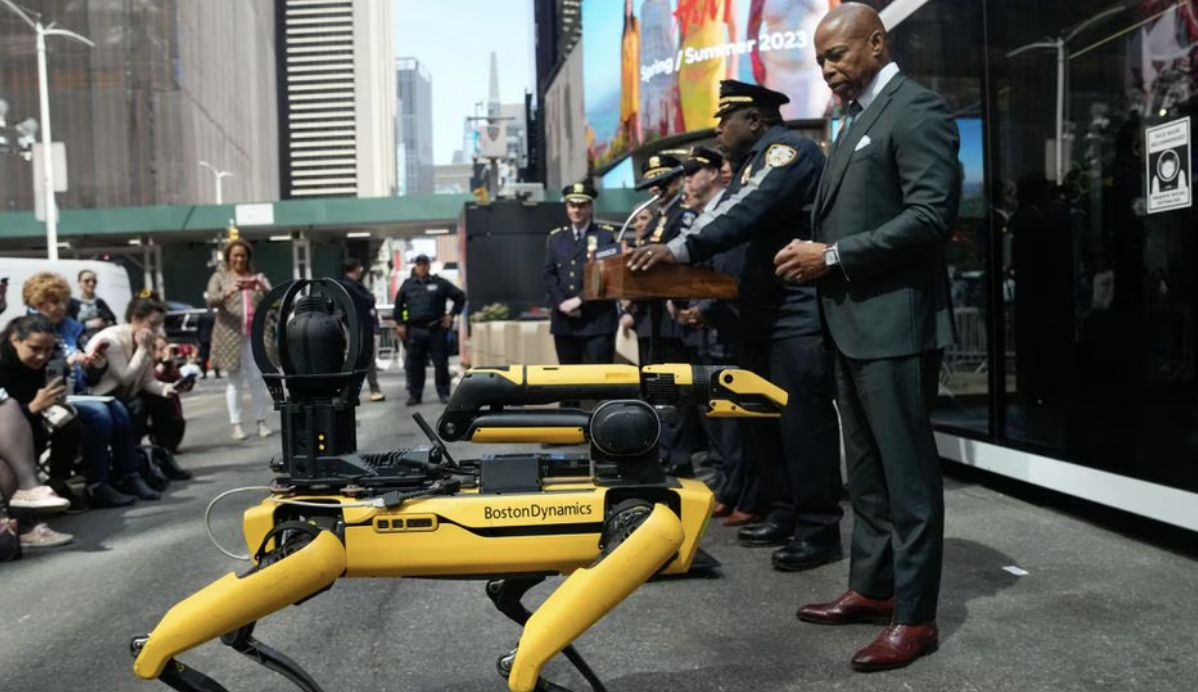After a couple of years in the doghouse, the policing technology nicknamed Digidog is returning to the mean streets of New York. Withdrawn by former New York City Mayor Bill de Blasio in 2021 after protests by civil liberties groups, the four-legged robotic friend, made by Boston Dynamics, is being brought back by current Mayor Eric Adams, alongside a Knightscope K5 security robot and a device that fires a GPS tracker onto a fleeing vehicle.
The K5, looking like a giant easter egg on wheels, is mainly equipped with cameras, microphones, and loudspeakers, and has form for running over a toddler in Silicon Valley and falling into a fountain in Washington DC. The dog, also equipped only with surveillance kit, was condemned as creepy and dystopian when first deployed in 2020.
The argument for more or less autonomous remote surveillance machines — eggs, dogs or drones — is that they can go into dangerous situations instead of risking human lives. Unarmed machines also pose less of a threat to a suspect than a nervous or angry human police officer with a gun. Nevertheless, the inhuman nature of the surveillance is symbolic of a relationship between police and policed that has little trust, let alone human warmth.
Yet the real issue here is not the robots, but instead the rules governing their use. In 2020 New York City Council passed the POST Act — Public Oversight of Surveillance Technology. Since then, the New York Police Department has been required to publish draft Impact and Use Policies for all surveillance technology it intends to use, or was already using before the POST Act came into force. This would include Digidog, K5, and any other shiny new toys the NYPD adds to its toolkit.
This is an admirable step in bringing police use of technology into the realm of public accountability, and goes well beyond what most UK forces do. The New York City Department of Investigation has oversight of these policies, and is responsible for checking that actual use of the technology follows the published policies.
Unfortunately, the NYPD interpretation of the POST Act is so loose that this oversight is impossible to carry out, as policies cover multiple technologies, and neither storage nor sharing of data are monitored or governed by the policies.
Meanwhile, Campaign group STOP (Surveillance Technology Oversight Project) noted that the return of the quadruped robot was announced without any Use and Impact Policy being made public, a potential violation of the POST Act. Their executive director Albert Fox Cahn also asked that the political figures rushing to condemn Digidog be more concerned about other surveillance technologies already in use, including facial recognition. “These tools may not be as creepy as Digidog,” he said, “but they’re far more dangerous.”
Cahn is right. Most police forces are already equipped with kit that makes privacy a fragile protection, and most of that kit is invisible to the objects of its attention. Uncanny though the four-legged robot is, the real questions New Yorkers — and all of us —need to ask are these: “Who watches the robotic watchdogs, visible and invisible? What policies form the leash that keeps their use within the law? And do their powers of oversight have teeth?”











Join the discussion
Join like minded readers that support our journalism by becoming a paid subscriber
To join the discussion in the comments, become a paid subscriber.
Join like minded readers that support our journalism, read unlimited articles and enjoy other subscriber-only benefits.
Subscribe